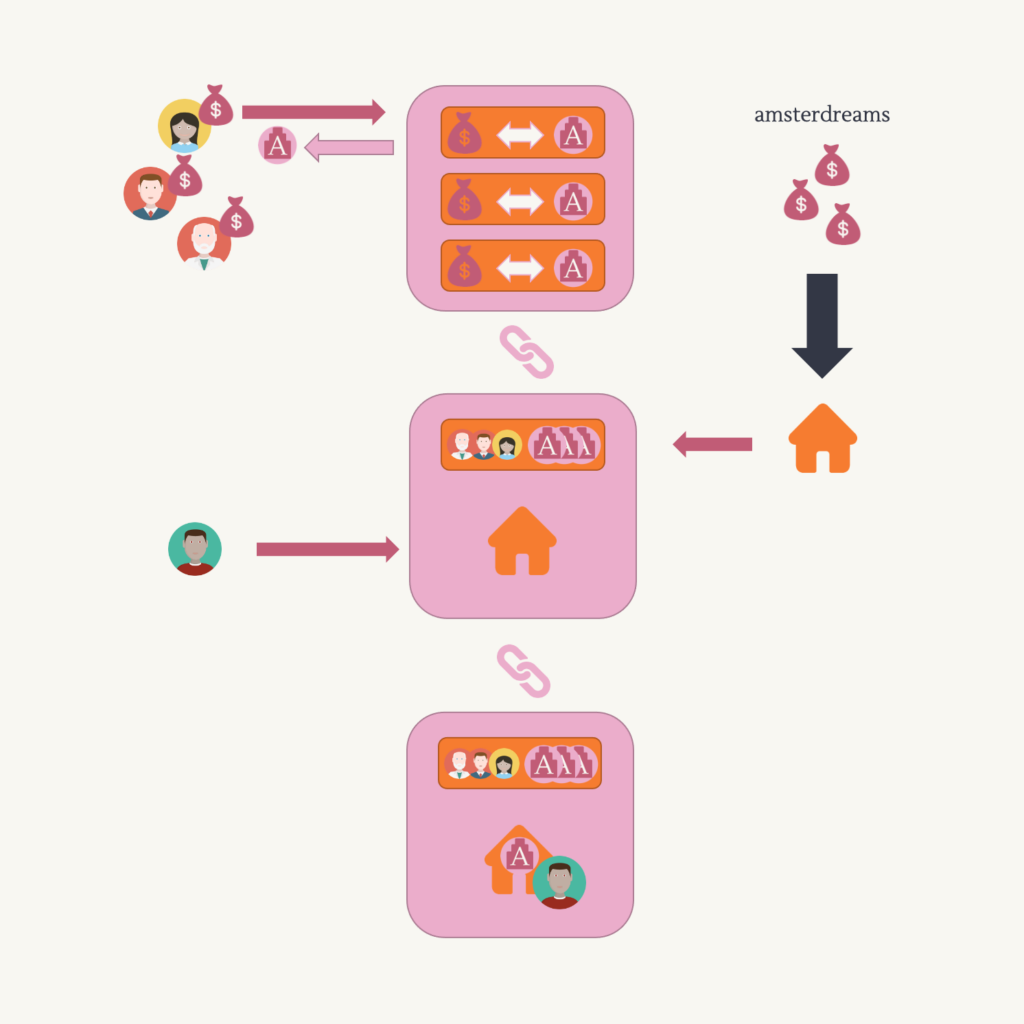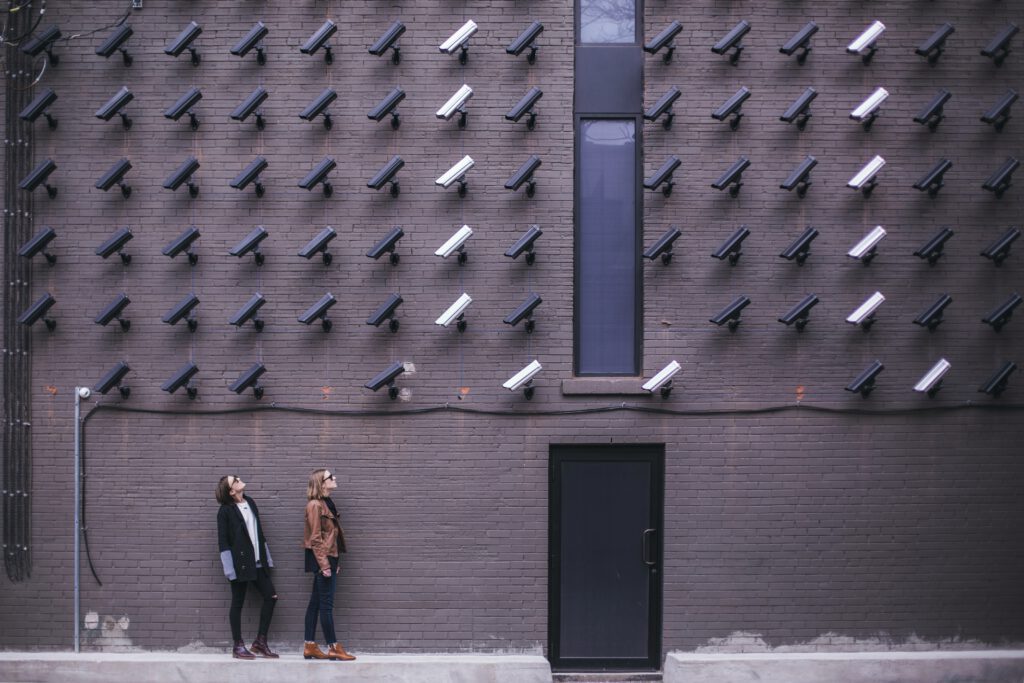TL;DR – amsterdreams revolves around the use of the AMS token, a secure building block that represents a piece of Amsterdam real estate. AMS exists on a blockchain, an unhackable public ledger that undisputably shows who owns what. AMS can be traded, but is not intended as a (crypto)currency.
What is a token?
A token is like a ticket, to a football game or a concert, that gives the bearer access to something. In the case of amsterdreams, the AMS tokens – named after Schiphol Amsterdam Airport – show partial home ownership. The more AMS tokens you have, the bigger the piece of Amsterdam you own.
For investors, who don’t live in an amsterdreams home themselves, the tokens are like assets, things of value. They can be bought with money and traded back for money, like bars of gold.
For our amsterdreams customers, who live in a home provided by amsterdreams, the tokens are more than that: they are the building blocks of home ownership. When a customer owns enough tokens, the home becomes fully hers, without any further need for amsterdreams services. Congratulations! 🥳

How do AMS tokens work?
AMS tokens make the value of a home in Amsterdam constant. The value depends on the size of the home, the location and facilities like gardens and roof terraces. But the value in AMS remains constant, say 500 AMS for a two-bedroom apartment in a popular area. The value in money, however, rises. That is the value increase amsterdreams investors benefit from. If 1 AMS is worth 1,000 euro today, it could be 1,100 euro a year from now.
Yes, but how do they work? Technically, I mean.
Great question. The AMS tokens are recorded on a blockchain. You may have heard of blockchain technology. If not, and if you’re interested, check out some of the links at the bottom of this article.
For the purpose of amsterdreams, what a blockchain does is make an immutable record of who owns what. This is a unique security feature of amsterdreams: all the investment in Amsterdam homes can be accounted for. The AMS tokens are on the blockchain and so are records of the properties purchased. Everyone can see how the money is being invested. That is an unprecedented level of transparency in the world of real estate! (sorry to boast, we’re quite proud of it)
An example. Let’s say George, Fatima and Bernard buy 120 AMS tokens each. amsterdreams buys a cute little apartment on the Joan Melchior Kemperstraat with the money they put in, in the fashionable Westerpark neighborhood. The home is then made available to customers for 360 AMS and in the end, Ahmed gets the allocation to the home. Ahmed puts the standard deposit of 3 AMS into the home contract. What is recorded on the blockchain now, is:
- George, Fatima and Bernard each own 120 AMS
- A house contract was created by amsterdreams, representing a value of 360 AMS
- The house contract is allocated to Ahmed, based on random allocation
- Ahmed’s investment in the home is 3 AMS

Money icons created by Freepik – Flaticon
Home button icons created by Freepik – Flaticon
Link icons created by Creaticca Creative Agency – Flaticon
This may seem simple and, honestly, not very exciting. But think about how this would look without the amsterdreams blockchain technology:
- George, Fatima and Bernard each invest 120,000 euro in a company
- This company buys a home for some amount, which is not public
- People apply to get the home for rent-to-buy, but how the allocation process works (and if it’s fair) cannot be determined
- A contract is signed between the company and the renter, the details of which are not public
What blockchain technology brings, therefore, is transparency, traceability and accountability. In the second example, our three investors have to have a lot of trust in the company they put their money into. Do they treat their customers fairly? Is the company making a disproportionate profit off of their investment? With the amsterdreams blockchain implementation, there is a clear, traceable and unforgeable record of who owns what.
Is AMS a cryptocurrency?
The term cryptocurrency is sometimes used interchangeably with blockchain. This is partly due to the fact the first major blockchain application was Bitcoin, a cryptocurrency intended as an alternative to dollars or euros, without the involvement of banks and governments.
AMS lives as an ERC20 token on the Ethereum blockchain. If that sentence has meaning to you, you can stop reading: you know enough.
If you’re less versed in terms like ERC20 and Ethereum – say, you’re like the rest of us – than suffice to say that AMS tokens can be traded freely, like coins. A well-known ERC20 token that is intended as a currency is Shiba Inu, with its ‘meme’, the Shiba dog.

Unlike Shiba Inu, however, AMS is not intended as a currency. It can be traded from one holder to the other without an intermediary, so you don’t need amsterdreams or any other exchange company in the middle. This is comparable to exchanging a sweater for a skateboard: a trade. While technically possible, we don’t expect you’ll be able to pay for pizza with AMS in the future any more than you would with skateboards.
The biggest difference between AMS and cryptocurrency, however, is what it is backed by. Most cryptocurrencies are backed by nothing – no gold, no governments, no existing currency – and their value is purely based on supply and demand. In other words, it is worth what people think it is worth. At the time of writing, Bitcoin is around $40,000 and Shiba Inu is at $0.000025. Don’t let that low number fool you, however: the total market capitalization of SHIB, as it’s known, is around 14 billion US dollars!
AMS is backed by the Amsterdam real estate market. Every AMS token represents a nominal value of 1,000 euro in housing and that amount goes up as the value in the property market increases. This is like the gold standard that existed for normal currency in the past. It protects AMS from the rapid value fluctuations that for instance Bitcoin is notorious for and from inflation (which is more or less the same thing).
What about privacy?
The public nature of the blockchain is great for transparency and traceability. You may wonder, though, if it’s a good idea to have a public record of who lives in which home and how much money they have invested in it. Bad actors could use that information for…well, the bad things they do – and also, you may decide that it’s none of anyone’s business!

This is why amsterdreams does not store any names on the blockchain. Neither of the investors, nor of the customers, nor the addresses of the homes. In other words, bad actors and other nosy parkers can only see that money has been invested and that homes are allocated to people. The names and addresses, however, are not on the blockchain. The only thing that is visible are wallet addresses, that look like this
0xb24abf582bab677c3bc8aa60706d212284a35b51In other words, all the money is accounted for, the allocation of homes and the investments in it are recorded, but the identities of the people involved and the addresses of the homes are replaced by meaningless codes.
Further reading
Wow, that was a lot to take in. But blockchain technology is a big subject. If you are hungry for more information, check out these articles on the web:




